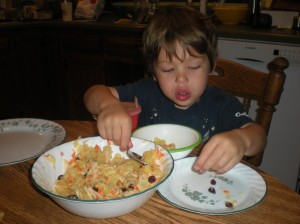As a single mom, I’m too busy to make separate meals to keep the low oxalate, medium oxalate and “regular’ dieters in my family happy. One of my solutions is to cook dishes where the high or medium oxalate ingredients can be added at the end of preparation (or at the table), allowing me to keep low-oxalate foods “separate” from the rest of the family’s meal without a lot of extra work. Apple pineapple salad is one of those dishes.
Last summer I thought it would be a good idea to introduce my boys (then 18 months) to raw vegetables. They thought otherwise. Bits of broccoli, cabbage and zucchini ended up on the floor, on the cupboards, in my hair, in my sons’ ears—everywhere but in their mouths. I kept offering and they kept refusing. Then I read a newspaper column by celebrity chef and father of four, Wolfgang Puck. He claimed a great way to get kids to try new foods was to introduce the new food gradually to something the child already likes. He was specifically referring to herbs and spices, such as adding tiny amounts of cumin or turmeric to steamed cauliflower to introduce the taste of curry, but to me this seemed like a sensible approach for introducing any new food.
Soon I was on the couch, flipping through cookbooks for inspiration. By the end of the evening I had developed this tasty fruit and veggie salad—one that quickly became a staple in our house. I especially like that it introduces kids to fresh salads— something very important to me as an avid gardener and salad lover. It’s also toddler-friendly as the whole salad is shredded or cut into tiny pieces. Best of all, it’s easy for me to leave the high oxalate carrots out of my portion or to substitute other low oxalate veggies.
It’s been almost a year since I introduced this salad and my boys still won’t eat most raw vegetables. But they love this salad—including the raw carrots and zucchini!
Apple Pineapple Salad
1 1/2 cups pineapple (or 1 can pineapple tidbits, packed in juice)
3 apples
1 small zucchini (about 1/2 cup when shredded)
1/3 cup raisins*
1 medium carrot,** shredded (about 1/2 cup) (see oxalate note)
Chop (or drain) the pineapple, reserving the juice. Peel and core the apples. Remove the ends from the zucchini and peel if desired. Shred the apples and zucchini and place them in a large serving bowl. Add the pineapple and 1/3 cup of reserved juice. Add the raisins and mix well. This is the low oxalate version of Apple Pineapple salad. You may eat the salad immediately or chill and serve it later. The pineapple juice keeps the apples from turning brown too quickly, so this salad can be made a few hours early or enjoyed the next day as a left-over.
For the non-low oxalate dieters in the house (or for those of you who can tolerate a little more oxalate in your diet), add shredded carrot to individual servings for a medium oxalate version of the salad (see oxalate note). Carrots add a pretty color to the salad, making it a lot more attractive for dinner guests (including Grammy and Papa), plus carrots add great nutrients, fiber, and crunch!
Servings: 6 adult servings (varies depending on how big your apples are)
*Raisins may pose a choking hazard for kids under three. Try boiling the raisins in pineapple juice until they plump (3-5 minutes in the microwave) to make them soft enough for a young child to chew.
**Oxalate Note: One half cup raw grated carrots has 15.3 mg. oxalate. When the salad is divided into 6 servings, the carrots add an extra 2.7 mg. oxalate per serving, pushing this version of the salad into the medium oxalate range (5-15 mg. oxalate per 1/2 cup). All other ingredients are low oxalate (less than 5 mg. oxalate per 1/2 cup).
Variation: Add 1-2 tablespoons of plain yogurt to make the salad creamy. You may also try adding bits of finely chopped broccoli or cauliflower.
Get the Kids to Help: Kids can add all of the ingredients to the bowl and mix the salad. Letting your picky eater help may also increase the odds that she will at least try the salad.
Picky Eater Pleaser: If your child will not usually eat “mixed foods,” try letting her sample a bite of each ingredient first. Then let her add the ones she likes to her own bowl to “mix” or not as she pleases. If your child is willing to eat mixed fruit salads, but you think she might balk at the carrots or zucchini, try adding a smaller amount of the vegetables the first time you make the salad. You can gradually increase the amount each time you make the salad or as your child shows a willingness to eat it.
Menu Planner: This is a great fall and winter salad when apples are in season and fresh produce is hard to find. Keep things simple by pairing it with grilled or baked chicken and steamed broccoli. I also like to serve this salad in the summer when I’m having a “summer salad meal”—a family tradition where the entire meal consists of fresh salads (most from the garden). My boys might pick at the rest of their meal, but I know they’ll fill up if this salad is on the menu
Other Dieters: Apple Pineapple Salad may be appropriate for gluten-free, dairy-free, vegetarian, vegan, Paleo, GAPs, SCD and controlled carbohydrate diets.



{ 2 trackbacks }